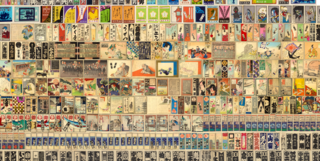-
[イベント情報]October 16, 2025(Thu)
The Call for Applications for 2026/27 International Joint Research Projects with Research Funds is open until 15 December (Mon), 2025, 12:00 noon (JST).
Beginning in FY 2026, we are launching the new category of International Early Career Researcher Projects in place of the International Joint Research Projects for which we have invited applications in the past (i.e., International Fixed Theme, International Open Theme, and Open Theme Projects). Meanwhile, we continue to welcome project proposals for International Joint Research to Utilize the ARC Research Space and for International Joint Research to Disseminate Research Through the Database System on a rolling basis year-round.
Call for Application: Categories of International Joint Research ProjectsA) International Early Career Researcher Project (with Research Funds)
B) International Joint Research to Utilize the ARC Research Space (without Research Funds)
C) International Joint Research to Disseminate Research Through the Database System (without Research Funds)N.B. The former 'International Joint Research to Utilize the ARC System for Educational Purposes' is integrated into B) International Joint Research to Utilize the ARC Research Space (without Research Funds).
How to Submit a ProposalPlease submit the application form for FY 2026 International Joint Research Project via the online platform below. After we have confirmed your submission, we will send you a confirmation of receipt by e-mail. If you do not receive the e-mail, please contact the Office of the Art Research Center.
Application Deadline for A) International Early Career Researcher Project (with Research Funds)Monday, 15 December 2025, Noon (JST)
Please see the Guidelines and apply though the online form, which are accessible here:Guidelines.pdf
Online Application Form
*If you are applying to A) International Early Career Researcher Project (with Research Funds), please download this Word file and upload it in the form of a PDF file on the Online Application Form:
Description of the Project and Research Expenses.docx
*If you are applying to B) International Joint Research to Utilize the ARC Research Space (without Research Funds), and if there is a co-researcher(s), please download this Excel file and upload it in the form of a PDF file on the Online Application Form:
List of Co-Researchers.xlsx
Selection Process and NotificationApplications for A) International Early Career Researcher Projects will be evaluated by the International Joint Research Reviewing Committee of the Art Research Center. We will send out the evaluation results in mid-March 2026 by e-mail.
Applications for other Research Project categories will be evaluated by the International Steering Committee of the Art Research Center on a rolling basis. We will send out the evaluation results within 2-3 weeks.
ContactTakuya Shimada (he, his, him)
International Joint Digital Archiving Center for Japanese Art and Culture (ARC-iJAC)
Art Research Center, Kinugasa Research Office, Ritsumeikan University
E-mail:r-darc (at) st.ritsumei.ac.jp (change "at" to @)[イベント情報]September 25, 2025(Thu)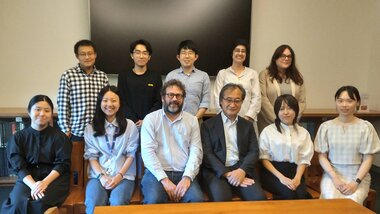
Organized by the Center for Japanese Studies (CJS), University of California, Berkeley, and the Art Research Center (ARC), Ritsumeikan University, a joint colloquium was held at the University of California, Berkeley, on September 17, 2025.
Date & Time: Wednesday, September 17, 2025, from 3:00 PM
Venue: East Asian Library, University of California, BerkeleyOrganizer: Art Research Center (ARC), Ritsumeikan University; Center for Japanese Studies (CJS), University of California, Berkeley
Supported by: International Joint Digital Archiving Center for Japanese Art and Culture (ARC-iJAC), Art Research Center, Ritsumeikan University(This was a closed event.)
Program
1. Modern and Contemporary Kyōyaki through Kiln Tools: A Case Study of the Fireclay Saggars from the Gorōsuke Asami Kiln
Presenter: Hina Kaneko(金子ひな)
2. The Transformation of the Tokyo Asahi Newspaper's Serialized Fiction in the Late Meiji Period (明治後期の東京朝日新聞における連載小説欄の変革)
Presenter: Subin Jeong (鄭スビン)
3. The Borrowing and Evolution of Illustrations in Enpon Parodies of Nise Murasaki Inaka Genji
Introduction
Presenter: Kirari Itami (伊丹稀星)
4. Dusk and Dawn of Literary Friendship: Santō Kyōden at the Turn of the Nineteenth Century (文の友、暮れと明け: 十九世紀をめぐる山東京伝)
Presenter: Yisheng Tang (唐藝晟)Reception
[イベント情報]September 22, 2025(Mon)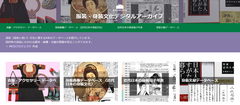
The Art Research Center (ARC), Ritsumeikan University, is pleased to share that the Shinsō Culture Digital Archive--adopted as an international joint research project by the ARC-iJAC in FY 2024 and FY 2025--has been featured on the blog of the North American Coordinating Council on Japanese Library Resources (NCC).
The Shinsō Culture Digital Archive investigates Japan's modern clothing culture through the concept of shinsō--the integration of body and clothing. Developed as part of the long-term Minpaku Costume Database Project (MCD), the archive is led by Dr. Haruko Takahashi (Visiting Researcher, National Museum of Ethnology) and realized through a cross-disciplinary collaboration that includes ARC faculty member Dr. Keiko Suzuki (Graduate School of Letters, Ritsumeikan University).
Among its four databases, the NCC blog highlights two in particular: the Chronology of Japanese Clothing Culture in the Modern Age Database, which reconstructs everyday dress and perceptions of the body from the Meiji Restoration to the end of World War II using contemporaneous newspapers, magazines, and catalogs; and the Image Database of Japanese Clothing Culture in the Modern Age, which leverages detailed illustrations from serialized novels and other materials to provide rare visual insights into styles and appearances of the time.
The ARC has supported the project by launching a dedicated portal site within the ARC Virtual Institute to enhance accessibility to these interdisciplinary resources both in Japan and internationally, aiming to broaden global engagement with Japan's clothing history and material culture.
Learn more about the project in the NCC's blog post "Japanese Studies Spotlight: Decoding Clothing Culture with the Shinsō Digital Archive," co-authored by Dr. Haruko Takahashi and Dr. Keiko Suzuki.
Explore portal site of the Shinso Culture Digital Archive in the ARC Virtual Institute: https://www.arc.ritsumei.ac.jp/lib/vm/shinsou/
[イベント情報]September 17, 2025(Wed)We are pleased to announce the 3rd Joint Colloquium co-hosted by the Center for Japanese Studies (CJS), University of California, Berkeley, and the Art Research Center (ARC), Ritsumeikan University.
Date & Time: Wednesday, September 17, 2025, from 3:00 PM
Venue: East Asian Library, University of California, BerkeleyOrganizer: Art Research Center (ARC), Ritsumeikan University; Center for Japanese Studies (CJS), University of California, Berkeley
Supported by: International Joint Digital Archiving Center for Japanese Art and Culture (ARC-iJAC), Art Research Center, Ritsumeikan University(This is a closed event.)
Program
1. Modern and Contemporary Kyōyaki through Kiln Tools: A Case Study of the Fireclay Saggars from the Gorōsuke Asami Kiln
Presenter: Hina Kaneko(金子ひな)
2. The Transformation of the Tokyo Asahi Newspaper's Serialized Fiction in the Late Meiji Period (明治後期の東京朝日新聞における連載小説欄の変革)
Presenter: Subin Jeong (鄭スビン)
3. The Borrowing and Evolution of Illustrations in Enpon Parodies of Nise Murasaki Inaka Genji
Introduction
Presenter: Kirari Itami (伊丹稀星)
4. Dusk and Dawn of Literary Friendship: Santō Kyōden at the Turn of the Nineteenth Century (文の友、暮れと明け: 十九世紀をめぐる山東京伝)
Presenter: Yisheng Tang (唐藝晟)Reception
[イベント情報]September 4, 2025(Thu)In addition to its world-renowned, extensive collection of ukiyo-e prints, the Victoria & Albert Museum (V&A) in London also holds a significant, yet long-overlooked collection of Japanese illustrated books (ehon).
Originally part of the National Art Library before being moved to the V&A's Asia Department, this collection comprises more than 1,700 volumes across approximately 500 different titles, spanning the 17th to 20th centuries.
Until recently, the collection had only been partially catalogued, with no comprehensive resource available. An ongoing research and digitization collaboration between the V&A's Asia Department, the Sainsbury Institute for the Study of Japanese Arts and Cultures (SISJAC), and the Art Research Center (ARC) is addressing this gap.
The project involves digitizing the books, compiling catalogue entries, and producing bilingual records (Japanese and English) for the V&A's Explore the Collections database.
Learn more about the collection, the project's background, and its achievements in the V&A blog post "Revealing the V&A's Japanese Illustrated Book Collection" by Caroline Gill.
URL: https://www.vam.ac.uk/blog/museum-life/revealing-the-vas-japanese-illustrated-book-collectionLondon, August 2025: Prof. Ryo Akama and his digital-archiving team with
Masami Yamada (Curator, Asia Department, Victoria & Albert Museum)Day 1: Friday, August 1, 2024 10:30-17:30(tentative)
Day 2: Saturday, August 2, 2024 10:00-18:30(tentative)Hybrid event (ARC, ZOOM, YouTube)
Please attend both days as long as time permits. Also, we will hold a WORKSHOP on August 2nd starting at 13:30. We hope you will participate. *Workshop (Kuzushiji Course, Video Archive Course)
ARC members will be informed of the ZOOM URL via e-mail.
Non-ARC members can participate von YouTube via the following link.(※一部配信出来ないプログラムもございます)
For inquiries, please contact the Office of the Art Research Center: arc-jimu@arc.ritsumei.ac.jp
Organizer: International Joint Digital Archiving Center for Japanese Art and Culture (ARC-iJAC), Art Research Center, Ritsumeikan University and Program for Supporting Research Center Formation, Ritsumeikan University
The 33rd Special Exhibition "川を描く、川をつくる―古地図で昔の堤をさぐる―" is held at the Lake Biwa Museum, supported by the FY 2024 ARC-iJAC project "Development of a database on traditional river management information in the Echi River, Shiga Prefecture, Japan."
Date: July 19 (Sat) - November 24 (Mon), 2025
Hours: 9:30 AM - 5:00 PM (last admission at 4:00 PM)
Venue: Special Exhibition Room, Lake Biwa Museum, Shiga Prefecture[イベント情報]June 16, 2025(Mon)The Art Research Center (ARC) at Ritsumeikan University is pleased to announce that more than 6,400 nōsatsu and senshafuda votive images in the University of Oregon Library's Gertrude Bass Warner Collection of Japanese Votive Slips (nōsatsu) have been made available online.
The Nōsatsu & Senshafuda University of Oregon Database can be accessed here:
https://www.dh-jac.net/db/nishikie/search_oregon.phpThe collection is also integrated into the ARC Nōsatsu Portal Database, here:
https://www.dh-jac.net/db/nishikie/search_Nosatsu.php.The University of Oregon Libraries' collection is the largest collection of Japanese shrine and temple votive slips in North America. They range in date from the 1850s to the 1930s and feature images representing a wide range of themes, from seasonal celebrations and observances, historical and fictional figures, and scenes of everyday life to objects, buildings, and landscapes. Some depict pilgrims or members of nōsatsu collecting & exchange clubs (nōsatsu-kai).
Senshafuda and nōsatsu are believed to have originated in the 18th century, as printed slips of text or images purchased by pilgrims and plastered onto walls or pillars at shrines and temples as a devotional act. They later became collectors' items, and by the end of the 19th century were actively traded in nōsatsu-kai not dissimilar to surimono poetry prints circles which were also vibrantly active at the time. (For more on the latter, see the ARC Virtual Institute "Salons and Networks in Kyoto and Osaka": https://www.arc.ritsumei.ac.jp/lib/vm/Salon/)
Most of the votive slips in the University of Oregon's collection today were originally acquired in the 1910s to 1920s by Frederick Starr (1858-1933), a professor of anthropology at the University of Chicago who reportedly became so active and prominent in nōsatsu-kai collecting & exchange clubs that he came to be known as "O-fuda Hakushi" (Dr. Votive Slips).
This digitization and database construction effort was initiated by Kevin McDowell, Japanese Studies Librarian at the University of Oregon, in 2015 and continued as an International Joint Research Project under the International Joint Digital Archiving Center for Japanese Art and Culture (ARC-iJAC) in 2020. Though the project was placed temporarily on hiatus due to the Covid-19 pandemic and other factors, we are glad to now make this significant resource available to the public. We hope this database will support future research in art history, material culture, religious studies, and related fields.
For image use beyond personal research, please consult the Reproductions and Permissions policies and contact information for Special Collections at University of Oregon Libraries: https://library.uoregon.edu/find-materials/special-collections-and-university-archives/reproductions-and-permissions.
(Some information above is drawn from: https://oregondigital.org/collections/gb-warner-nosatsu, as well as from Kevin McDowell, "Echoes of Edo in the University of Oregon's Japanese Votive Slips Collection," presentation at European Association of Japanese Resource Specialists annual conference, 2024.)
[イベント情報]June 11, 2025(Wed)On June 9, 2025, the Art Research Center (ARC) at Ritsumeikan University signed a Collaboration Agreement for Joint Academic Research with the History of Content Industry Archives Research Center (HARC) of ZEN University.
The signing ceremony took place at Ritsumeikan University's Kinugasa Campus and was attended by Professor Koichi Hosoi, Director of the HARC, and Professor Ryo Akama, Director of the ARC and faculty member of the College of Letters.
Through the conclusion of this collaboration agreement, the two institutions aim to establish a digital archive of oral history interview videos video oral histories and materials related to dōjin creative works in the field of media arts content, with the following objectives:
1. The collecting and archiving of oral history interview videos video oral histories of individuals active in the fields of media arts--particularly manga, anime, and games--as well as the IT and internet culture sectors. These materials will be organized and made publicly available through a digital archive, transforming them into valuable scholarly resources for the study of modern Japanese popular culture.
2. As a 'Real-Time History Project,' the initiative seeks to promote the scholarly use of primary materials related to Comic Market (Comiket), Japan's largest convention for dōjin creative works. Issues related to the digitization and use of catalog booklets from past events as research materials will be examined, while building a digital archive to preserve and safeguard these materials.
About the HARC, ZEN University:
Established on September 30, 2023, the HARC is dedicated to the comprehensive and in-depth collection and preservation of primary materials related to people, objects, and events that have shaped the history of Japan's content industry. The HARC's mission is to make these archival materials available to the public for scholarly research, education, and the creation of new industries, contributing to their meaningful use in society.
[イベント情報]June 3, 2025(Tue)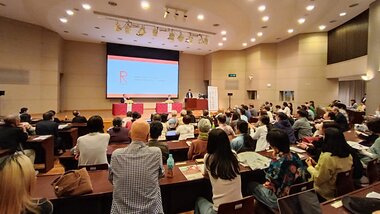
On June 1, 2025, Ritsumeikan University's Kinugasa Campus hosted the KINUGASA ART VILLAGE FESTIVAL to commemorate the 125th anniversary of the founding of the Ritsumeikan Academy.
As part of the festival, the Art Research Center (ARC) held an art dialogue titled 'Ukiyo-e and its Global Reach,' featuring two renowned ukiyo-e experts: Dr. Shugo Asano and Prof. Ryo Akama.
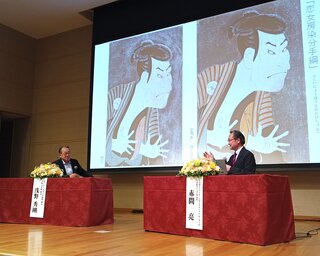
Dr. Shugo Asano serves as the President of the International Ukiyo-e Society and is the Director of both the Abeno Harukas Art Museum in Osaka and The Museum Yamato Bunkakan in Nara.
Prof. Ryo Akama, of the College of Letters at Ritsumeikan University, is the Director of the ARC and a pioneer in the digital archiving of Japanese art held in overseas collections, having spearheaded the creation of the world's largest ukiyo-e online research database.
Ukiyo-e, widely recognized through its presence on banknotes, passports, and popular TV dramas, also includes many lesser-known works that have remained 'hidden' within museum collections around the world. During their conversation, Dr. Asano and Prof. Akama highlighted the enduring appeal of ukiyo-e and discussed how masterpieces by artists such as Hokusai, Kunisada, and Kuniyoshi are exhibited not only in Japan but also in prestigious museums worldwide, including the British Museum and the Museum of Fine Arts, Boston.
Their insightful exchange offered attendees a unique opportunity to deepen their understanding of ukiyo-e's cultural significance and its far-reaching international influence.
Looking ahead, with the establishment of the College of Arts and Design on Kinugasa Campus next year--where Prof. Akama will serve as dean--Ritsumeikan University is excited to host further events that celebrate and explore Japan's extensive artistic heritage in a global context.




